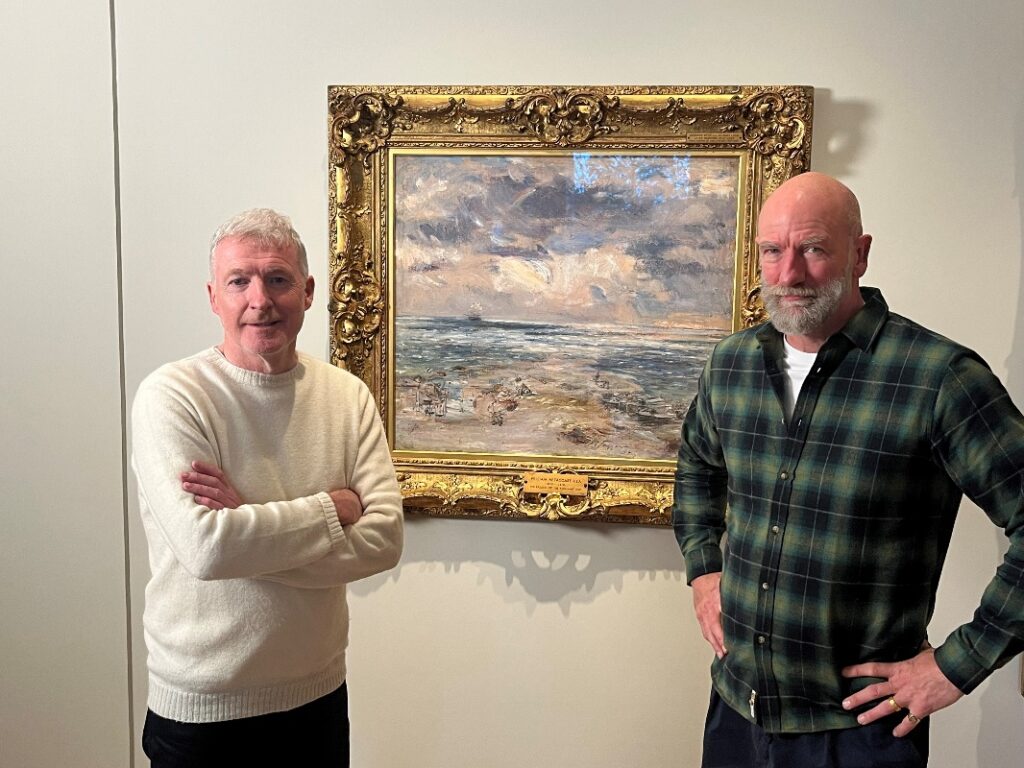National Galleries of Scotland release new short film starring Outlander star Graham McTavish

Scottish film star Graham McTavish dives into the dramatic seascape that is William McTaggart’s The Sailing of the Emigrant Ship in the newest film in the Perspectives series by National Galleries of Scotland. Released today (6 February) the Outlander actor explores how the painting resonates with his own personal experiences of emigration and shares his research into the passage of Scots to New Zealand during the Highland Clearances.
McTavish has long been engrossed in the extraordinary history of Scotland, exploring the heritage of his birth country and its people. Together with Outlander co-star Sam Heughan, the intrepid Scotsmen recently published a book on their adventures journeying across New Zealand, Clanlands in New Zealand: Kiwis, Kilts, and an Adventure Down Under. While exploring the new Scottish galleries at the National in Edinburgh, which is home to the nation’s historic collection of Scottish art from 1800 to 1945, McTavish became gripped by the work of McTaggart and the significance of the moments captured in his paintings.
The Sailing of the Emigrant Ship, painted in 1895, depicts a ship of Scottish emigrants moving off under a stormy sky, with a glimpse of a hopeful rainbow in it. On the shore, other members of the clan have been left behind. In the Perspectives film, McTavish discusses the painting with the National Galleries of Scotland’s Outreach Co-Ordinator, Robin Baillie, detailing his research. McTavish admits that Outlander has played some part in romanticising these landscapes, but that it is important to remember the historical significance of what these people went through.
‘I don’t think we can imagine it now, what it must have been like for Scots in the 1800s. Wearing big woollen coats and getting on the boat knowing it could take about 120 days on average to get to New Zealand. The rainbow in the painting is showing this idea of a promised land, but a lot of them were sold a lie. Those people were told there were beautiful plots of land for them to farm on, but when they arrived it was thick bush down to the shoreline and precipitous cliffs. They must have got there and thought “we have been robbed” but they didn’t have the option to turn back, they had to get off the ship.’
McTavish has spent years discovering Scotland’s torrid history and is fascinated by how this has changed Scotland’s landscapes and how the country is viewed worldwide today. The Sailing of the Emigrant Ship is one of very few 19th-century paintings which explore this topic directly ̶ the wider topic of the Highland (and Lowland) Clearances is also addressed in the new Scottish galleries through the interpretation and in landscape paintings.
‘I speak to many, many people, Americans in particular, and when they talk about that Scottish landscape, I try to explain they are experiencing a landscape which has been decimated. The emptiness of those glens and straths, that wasn’t how they were. And now they talk about the great vistas and beautiful views across the mountains, views that would have been populated by people living and having their own communities. But the absence of those people is what tells the story of those clearances.’
Having moved around from a young age, McTavish was born in Scotland, then his family relocated to London before emigrating to Canada, and then (several years later) to New Zealand. Exploring his experience, McTavish shares his own resonance with the painting.
‘In the book Sam and I just published, Clanlands in New Zealand: Kiwis, Kilts, and an Adventure Down Under, I became particularly interested in the emigration of Scots to New Zealand and what that experience would have looked like. I was an emigrant, first of all I left Scotland to go to England, then I left there to go to Canada. You feel very alone, I think is one way of describing it. I felt this enormous pressure to speak in a Canadian accent, it sounds silly, but I was 8 and I wanted to fit in. So, to think of all these people that are portrayed here and what they left behind and the unknown they were going to – it really is amazing.’
‘There’s a courage involved in stepping off the shore of your home and knowing you may never return. It takes a particular type of person or a particular type of circumstance that takes you there. Many of them would have had no choice.’
In the recently released Perspectives film, McTavish explores how McTaggart’s painting evokes his own memories of emigrating throughout his life and the emotions it sparks.
‘I have made choices in my life that have moved my family across the world but that was nothing compared to what these people did. I made the decision to move to LA from London, with my wife and child. I remember telling friends at the time and they’d say “what, you’re moving to America? When am I ever going to see you”. And that’s in the 21st Century. It would have been a knife in the heart for a lot of these people in the painting, doing that in the 1800s and never seeing many of your loved ones again.’
‘It would have been this tangle of emotions that they would have felt. There would be some sort of feeling of hope, along with the desperate need for change. So desperate that it would force them to leave the place they loved and grew up in.’
‘To me the artist’s choices, of how McTaggart depicts the people, in the painting shows this. They look like they are disappearing, they are fading, they are not fully fleshed out and you can see through them. It is that sort of sense that the world is just dissolving. For the people looking back that is what they are seeing, their world as they know it disappearing.’
Throughout his travels and living in locations across the world, McTavish notes that the Scots he has met along the way have a strong pride in their heritage. McTavish himself admits he feels lucky that he always has Scotland to come back to. Reminiscing about one particular line by his character Dougal in the hit TV show Outlander, he says it was a significant line for him to say, not just for the character but for himself.
‘Catriona Balfe’s character, Claire, talks about Dougal’s narcissism and how he is self-obsessed. He stands there and he takes the insults and then he says, “you’re right, it’s true I do love myself, but I love Scotland more”. It meant so much for me to say that and to give him that grounding. We can all look at people like Dougal and think “what was he thinking?” But during that period of the second Jacobite rebellion, they really thought they could win, they absolutely did.’
‘Starting in Scottish theatre, I was constantly moving I didn’t have a sense of rooted home, wherever I was I made it home. But it is strange whenever I come back to Scotland there is a deep feeling of relief when I get here. It’s just a sense of real belonging, I don’t have a home in Scotland but when I am here, I feel at home.’
There is even more Scottish art, history and stories to discover at the new Scottish galleries at the National. Dive into dramatic landscapes, encounter iconic images and be wowed by colour. A free experience for everyone right in the heart of Edinburgh’s city centre.





